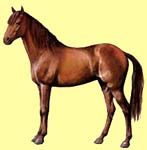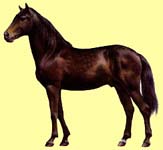|
|
Lusitano |
|
|
Lusitano |
 The Lusitano is believed by some to be the Portuguese version of its illustrious neighbor, the Spanish Andalusian. While there is no doubting its ancestor is the
Spanish Horse, the Lusitano has developed a little differently from the Andalusian, probably because of an
Arabian outcross. The horse shows a lot of daylight between its body and the ground, and is more "on the leg" (as it's called) than the
Andalusian. (Note: "Andalusian" is an American name; the breed is more popularly known in Europe as the Spanish Horse.)
The Lusitano is believed by some to be the Portuguese version of its illustrious neighbor, the Spanish Andalusian. While there is no doubting its ancestor is the
Spanish Horse, the Lusitano has developed a little differently from the Andalusian, probably because of an
Arabian outcross. The horse shows a lot of daylight between its body and the ground, and is more "on the leg" (as it's called) than the
Andalusian. (Note: "Andalusian" is an American name; the breed is more popularly known in Europe as the Spanish Horse.)
The Lusitano was once the mount of the Portuguese cavalry. It was used for light agricultural work as well as for general riding and as a showy carriage horse. The breed's principle claim to the fame is on account of it's choice as a partner for the Portuguese bullfighter - called the rejoneadore.
In Portugal, the bull is not killed and it would be a disgrace for the horse to suffer injury. In consequence, the very valuable horses of the rejoneadores are highly schooled in the most advanced movements. To face the charging bull and to work the enraged animal call for great courage and exceptional agility - qualities that the Lusitano possess in full measure.
The Lusitano is a very cooperative, intelligent and responsive breed and consequently, it is well suited to the discipline of the hauté ecole. As a result, it is also in growing demand for use as a dressage horse. Although the Lusitano must be quick and balanced, the action tends to be elevated, which is not detrimental to its use in the bullring, nor as a carriage or dressage horse. While the Lusitano is perhaps no more than the Andalusian with a different accent and, indeed, it has much of the Andalusian's more noticeable characteristics, it lacks the latter's "noble" presence. Nonetheless, it has all the courage of the Spanish Horse.
The Lusitano's head is fine and small with small ears and jaws. Its shape inclines more towards the Andalusian and the profile is more likely to be straight than dipped after the Arabian fashion. The neck is placed well into the strong shoulders, which contributes to the balance and agility, but it is somewhat thick and short.
The Lusitano is not perfect in respect of its conformation, but it has the compensatory asset of a pair of powerful shoulders. In many horses of the breed, the depth of girth is less than might be expected in what is otherwise a compact and athletic horse.
Despite the length of the forearm, the Lusitano has a conformational failing in the length of the cannons. These are overly long and contribute to the appearance of the horse being "on the leg." They average 15-16 hands high.
With his short back, good loin and the powerful sloping quarters, all compliment the excellence of the shoulder, and makes up for any other failings.
Despite a probable infusion of Arabian blood, the full, wavy tail, derived from the Andalusian, is set rather lower than might be expected. It is not carried in the Arabian fashion.
The Lusitano comes in every sort of solid color, but is predominantly grey. The dun color (similar to buckskin) inherited from the Andalusian, is less usually seen.
 From one of our visitors:
From one of our visitors:
Lusitano horse with accordance to Archaelogical evidence dates back to 25,000 B.C.and come from the Sorraia breed. the Sorraia is believed to be crossed with native Iberian Proto Draft Horses (Equus Caballus Caballus of western Europe and ancient strains of Oriental/North African horses.) These horses are named Lusitano after the Lusitania's nation (What now is Portugal and some of western Spain) That is why this horse is called the "Son of the Wind and Pride of Portugal" This is not a Spanish horse. Spain would like you to think that.
Please note that we have not said that the Lusitano is a Spanish horse or that it originated in Spain. It does, however, share the same origins as other modern Spanish breeds and it is based on the old Spanish Horse. Look for an update on this article and more information on the Spanish Horse of history.
For more information on Lusitanos, visit:

|
© 1997-2007
NW Breyer Horse Club & Refiner of Gold Creations Equinealities in place since 1997, Section in place 2001, Updated 3/13/2007 |



|
| ||

|
|||||